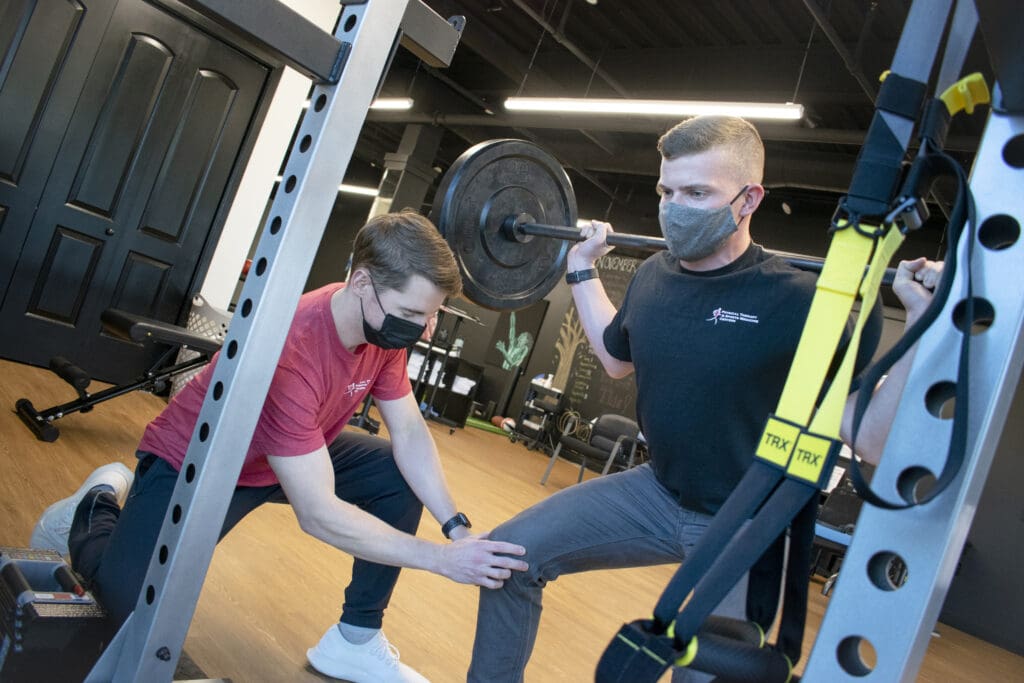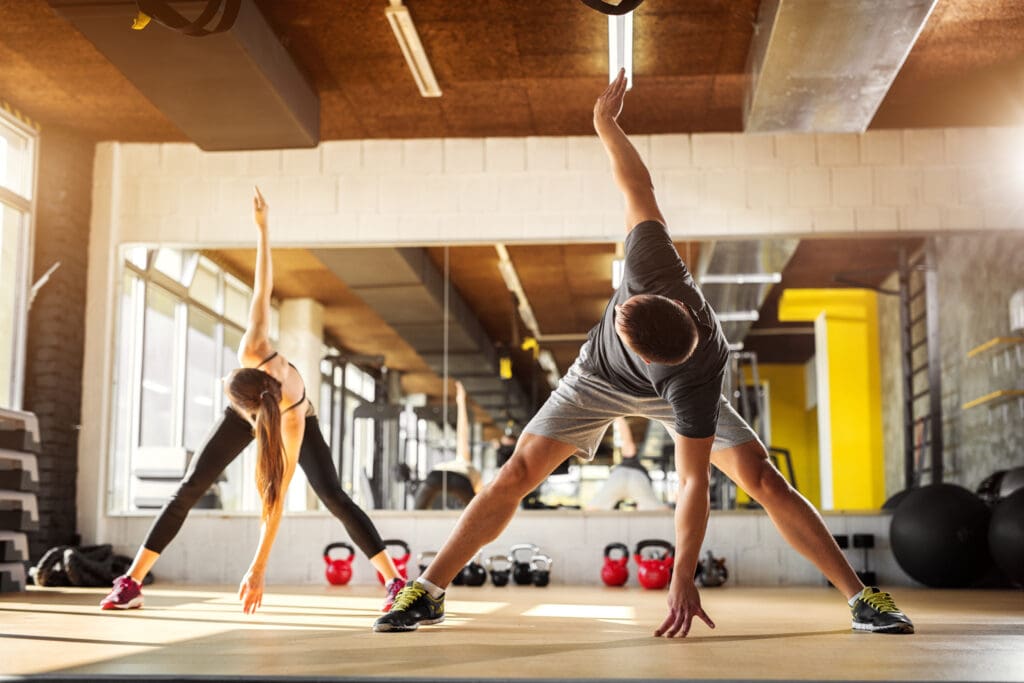Injury Prevention in the Gym: Physical Therapists Share Best Practices to Reduce Risk and Maximize Workouts

Whether you are just starting your fitness journey or you’re a seasoned gym rat, there’s nothing worse than an injury that keeps you from the gym.
It can especially be daunting if you are just starting to go to the gym. It’s hard to know what exercises to do that will actually help you without risk of injury, so our physical therapists wrote some helpful tips to avoid injury and maximize your gains!
Stick to the basics
 Social media is full of trendy workouts and exercises, but these are often complicated and tricky to nail down. The truth is that you will benefit more by just sticking with the basics. Compound movements are the most beneficial and efficient exercises that you can do. These are exercises that work multiple muscle joints, ie the squat, which moves both the knee and hip joints. Compare this to leg extension, which only focuses on the knee joint. While exercises like leg extension have a place, you should focus on compound movements that give you the most bang for your buck. One way to do this is to put your compound movements at the beginning of your workouts when you have the most energy. Of course, having proper form is also important when reducing your injury risk. If you’re concerned about your form, consult a professional to get the most accurate feedback.
Social media is full of trendy workouts and exercises, but these are often complicated and tricky to nail down. The truth is that you will benefit more by just sticking with the basics. Compound movements are the most beneficial and efficient exercises that you can do. These are exercises that work multiple muscle joints, ie the squat, which moves both the knee and hip joints. Compare this to leg extension, which only focuses on the knee joint. While exercises like leg extension have a place, you should focus on compound movements that give you the most bang for your buck. One way to do this is to put your compound movements at the beginning of your workouts when you have the most energy. Of course, having proper form is also important when reducing your injury risk. If you’re concerned about your form, consult a professional to get the most accurate feedback.
Train for Function
While it’s great to lose weight or hit a new personal record, it’s also important to train for longevity and being able to function in all stages of life. As we age, we lose strength and mobility, which makes movements like walking or sitting down more difficult. We can prevent that loss of ability by training the muscles that complete those movements.
There are five basic types of movements that you should try to incorporate into your weekly workouts:
1. Push movement
Examples: Chest Press, Shoulder Press, Pushups, Tricep Kickbacks
2. Pull movement
Examples: Bent Over Rows, Bicep Curls, Pull-ups, Lat Pull-downs
3. Bending and Lifting Movements
A. Hip Hinge | Examples: Deadlift, Romanian Deadlifts (RDLs), Glute Bridges
B. Squats | Examples: Goblet Squats, Back Squats, Front Squats, Sumo Squats
4. Unilateral (one-sided) Movements
Examples: Lunges, B-Stance RDLs, Single Leg RDLs
5. Functional Core Movements
Examples: Plank, Deadbugs, Woodchoppers for rotation
Create a well-rounded fitness routine
No matter what your goal is, it’s vital to create a well-rounded fitness routine for yourself. If you are hopping on the treadmill for an hour and not doing any strength training, you’re putting yourself at risk for injury and not reaping the maximum benefits of going to the gym.
The same goes for someone who only does chest workouts, for example. If you are only focusing on your chest, you’re probably neglecting your back and your legs, which will lead to a major imbalance and leave you at risk for injury.
Incorporating the five types of movements into your workouts will help you to create a well-rounded fitness routine, but you might have specific areas that are already weak that you need to focus on. Some common areas are the glutes, upper back muscles, and core. Learn more about common weak areas and how to train them in this blog post.
Learn to Progress Efficiently
As we get stronger, our workouts will start to feel easier. The same workout you did two weeks ago might a breeze, or you might not be as sore the next day. You need to keep challenging yourself in the gym to see results. That means making your workouts progressively harder, but it’s important to progress at a rate that is not too challenging. If you ran 1 mile one day, you wouldn’t try to run 10 miles the next day. The same thing goes for weights.
You want to follow a principle called progressive overload, which basically states you need to gradually increase the intensity of your workouts. A fitness professional can help you to progress your workouts safely and efficiently, but there are a few different ways you can increase the intensity:
- Increase weight
- Increase reps
- Increase sets
- Increase training frequency
- Decrease rest time
It’s important to remember that you shouldn’t increase multiple variables at once. If you increase the weight, you shouldn’t also increase reps. A general rule of thumb is to increase your intensity by 10% or less week by week. Otherwise, you might be increasing the intensity too much which can lead to injury.
Don’t Skip Your Warm-Up
 For most of us, the winter months are frigid, which makes it even more important to warm up before your workout.
For most of us, the winter months are frigid, which makes it even more important to warm up before your workout.
Why does warming up matter? According to Melissa Boutagy, Physical Therapist at PTSMC Guilford, “Warming up before your work out increases heart rate and circulation, loosens the joint, and increases blood flow to the muscles. It decreases your risk of injury by keeping the muscles warm and loose, preventing acute and overuse injuries.”
To accomplish this, you should perform dynamic stretches during your warm-up, which are moves that take the joints through their full range of motion. You move through them, vs. static stretches that you hold for a set amount of time to feel a stretch. Static stretches should be done after your workout to help cool-down the muscles.
Not only will the warm-up help you to perform your best during your workout, but doing these types of drills regularly will help you to improve your mobility and flexibility, which naturally decrease with age when we don’t use them. Just like training your muscles for strength, we need to train our bodies to be more mobile.
These 5 tips are a great place to start or to reevaluate your current workout routine. Following these best practices may lower your risk for injury and maximize results in the gym. Remember to be safe and aware of your surroundings. If something doesn’t feel right, consult a physical therapist.
